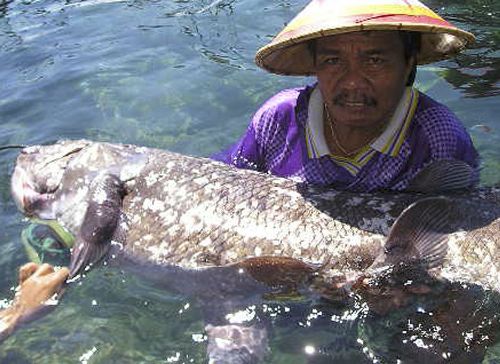
July 29, 2007

Indonesian fisherman Justinus Lahama holds up a rare coelacanth, an ancient fish once thought to have become extinct at the time of the dinosaurs. (Reuters)
Scientists excited by Indonesian-caught coelacanth fish
Two months ago Indonesian fisherman Justinus Lahama caught a rare coelacanth fish that has now lured an international team of scientists to investigate how he caught it.
French experts equipped with sonar and GPS asked Mr Lahama to reconstruct in his dugout canoe, exactly what it was he did that enabled him to catch the coelacanth fish, an awkward-swimming species among the world’s oldest.
Last May 19, Mr Lahama and his son Delvy manoeuvred their frail canoe into the Malalayang river, on the outskirts of Manado, on northern Sulawesi island.
Like any other morning, they rowed out to sea and fished within 200 metres of the beach.
“I very quickly unrolled the usual trawl line with three hooks, about 110 metres long and at the end of three minutes, I felt a large catch,” Mr Lahama said.
The pull was strong: “I had painful arms — I felt such a resistance, I thought that I was pulling up a piece of coral”.
After 30 minutes of effort under the searing tropical sun, he finally saw a fish swishing at a depth of about 20 metres.
“The sea was very calm this day. There was no wind, no clouds, no current. The water was very clear. The fish let itself be drawn in from there,” he said.Dreaming
He says he thought he was dreaming when he saw the creature at the end of his line.
“It was an enormous fish. It had phosphorescent green eyes and legs. If I had pulled it up during the night, I would have been afraid and I would have thrown it back in,” he said.
Coelacanths, closely related to lungfish, usually live at depths of 200-1,000 metres.
They can grow up to two metres in length and weigh as much as 91 kilograms.
Mr Lahama, 48, has fished since he was 10 years old, like his father and his grandfather before him.
But he was unlikely to have ever run into this “living fossil” species, as scientists have dubbed the enigmatic fish.
Mr Lahama’s catch, 1.3 metres long and weighing 50 kilograms was only the second ever captured alive in Asia.
The first was caught in 1998, also off Manado.Scientists astonished
That catch astonished ichtyologists, who until then had been convinced that the last coelacanths were found only off eastern Africa, mainly in the Commoros archipelago.
They had been thought to have died out around the time dinosaurs became extinct, until one was found there in 1938.
Their fossil records date back more than 360 million years and suggest that the fish has changed little over that period.
Mr Lahama, who had never even heard of the fish, initially thought of selling his white-spotted catch.
“Considering his weight, I said to myself, this will fetch a good price,” he said.
Returning to port, he showed it off to the most senior fisherman, who became alarmed.
“It is a fish which has legs – it should be given back to the water. It will bring us misfortune,” one senior fisherman told Mr Lahama.
But the unsuperstitious Mr Lahama decided to keep it.
After spending 30 minutes out of water, the fish, still alive, was placed in a netted pool in front of a restaurant at the edge of the sea. It survived for 17 hours.
The local fisheries authorities filmed the fish swimming in the metre-deep pool, capturing invaluable images as the species had only previously been recorded in caves at great depths.
Once dead, the fish was frozen.
After the fisherman was interviewed, French, Japanese and Indonesian scientists working with the French Institute for Development and Research carried out an autopsy on the coelacanth.
Genetic analysis is to follow. – AFP, Australian Broadcasting Corporation, July 29, 2007.
About Loren Coleman
Loren Coleman is one of the world’s leading cryptozoologists, some say “the” leading living cryptozoologist. Certainly, he is acknowledged as the current living American researcher and writer who has most popularized cryptozoology in the late 20th and early 21st centuries.
Starting his fieldwork and investigations in 1960, after traveling and trekking extensively in pursuit of cryptozoological mysteries, Coleman began writing to share his experiences in 1969. An honorary member of Ivan T. Sanderson’s Society for the Investigation of the Unexplained in the 1970s, Coleman has been bestowed with similar honorary memberships of the North Idaho College Cryptozoology Club in 1983, and in subsequent years, that of the British Columbia Scientific Cryptozoology Club, CryptoSafari International, and other international organizations. He was also a Life Member and Benefactor of the International Society of Cryptozoology (now-defunct).
Loren Coleman’s daily blog, as a member of the Cryptomundo Team, served as an ongoing avenue of communication for the ever-growing body of cryptozoo news from 2005 through 2013. He returned as an infrequent contributor beginning Halloween week of 2015.
Coleman is the founder in 2003, and current director of the International Cryptozoology Museum in Portland, Maine.
Filed under Breaking News, Cryptotourism, CryptoZoo News, Cryptozoologists, Cryptozoology, Expedition Reports, Eyewitness Accounts, Forensic Science, New Species